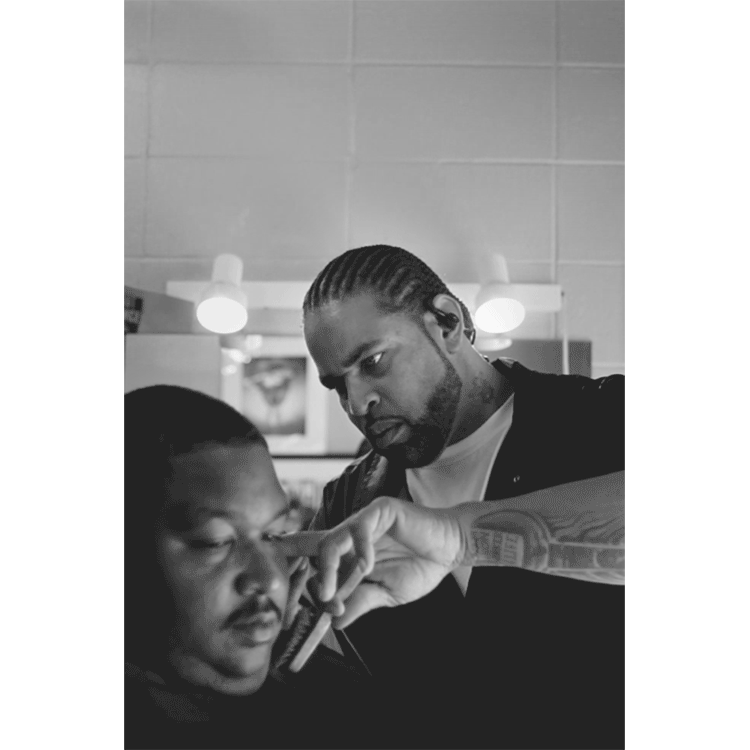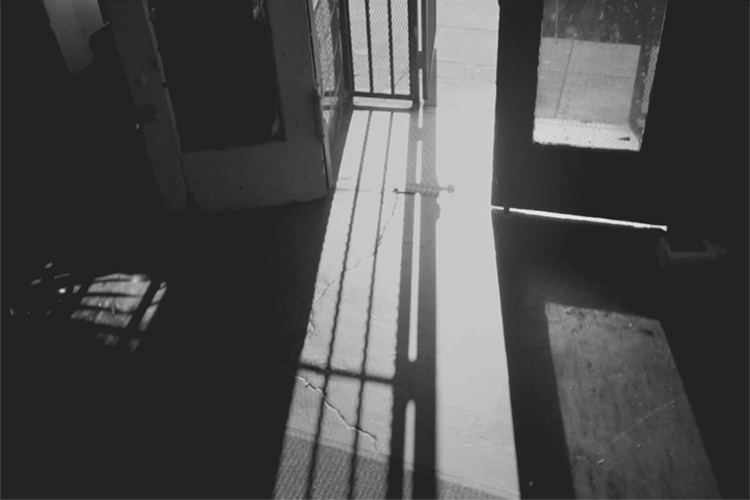© Brandon Tauszik
For the past 4 years, Brandon Tauszik has been making portraits of historically Black barber shops in Oakland California, using GIFs made from looped video footage. Resting somewhere between narrative and documentary, Tauszik's series "Tapered Throne" paints a quiet snapshot of businesses that have served as pivotal community hubs for over a century, and continue to thrive in spite of rapid urban gentrification. Despite being white, and in many ways, an outsider, Tauszik's thoughtful approach has earned the trust of the men he photographs, and presents an intimate view of barbershop culture that, as historian Quincy T. Mills writes, "are constantly in motion and in tune with the comings and goings of the people in their city." We spent some time with Tauszik to learn more about his creative process and motivations.
Humble: Tell us about yourself. How does photography help you respond to the world, tell stories, etc?
Brandon Tauszik: I was raised in England, then moved to Florida in my teens. I’m currently based in Oakland, California where my life is equal parts film and photography. I direct music videos and commercial content at Sprinkle Lab while also pursuing personal photography projects. I came to photography while backpacking through Eastern Europe extensively in my early twenties. It was a way to decipher a part of the world I did not understand and a useful excuse to interact with strangers. Since then I’ve enjoyed developing a deeper relationship with photography, which ultimately allows me to explore various subjective elements of the human experience.
© Brandon Tauszik
What inspired you to pursue this project?
My interest grew from observing the complete absence of corporate shops like Fantastic Sams or Supercuts here, there is solely an abundance of independently owned shops. I scouted a few of the older ones in my neighborhood and began to pay visits. These shops were incidentally what you would consider black barber shops, with completely African American staff and clientele.
As a white guy with unkempt hair, I was very out of my element, both socially and mentally. I was curious to learn more about the motivations behind these men. After conducting interviews with a few barbers, they illuminated the differences between cutting straight and kinky hair and also the social importance of these spaces to the black community in Oakland. At that point, I took the project in a new direction - with the intent to create a portrait of Oakland’s black barbers and the less visible roles they assume.
How does this work relate to your own background/ identity?
Black barbershops in no way relate to my own personal background. I’ve had a couple people ask me if that invalidates the work in some way and I firmly believe the answer is no. I presented people saying what they do via the quotes, exhibited how I saw them via the GIFs, and provided an African American academic perspective via the essay by Quincy T. Mills.
As an image maker, you are obligated to think long and hard about how one’s subject matter can be portrayed with honesty and integrity. Indeed the potential is there for misrepresenting your subject, but I think it is a half baked notion that only a soldier should photograph war or only a Southerner should photograph the South.
© Brandon Tauszik
Why the focus on Oakland specifically?
Oakland is a remarkably diverse city with a thriving African American community dating back to the Great Migration. That population has created a lasting demand for demographically specific goods and services, particularly barbers. I still discover new shops that I never noticed before when I’m wandering around town. The project could be five times larger if I wanted to spend a few more years on it. That being said, the past couple decades have brought significant changes to Oakland. The tech industry’s booming economy is centered just a short drive away in Palo Alto, San Jose and San Francisco. There is a steady influx of new residents to feed that job market which has put a great strain on basic resources, especially housing. Historically Black neighborhoods are now rapidly gentrifying and Oakland’s African American population has declined by 22 percent between 2000 and 2010. Right now, there is still a strong African American presence here and thus these shops are thriving. However if that population here continues to weaken, then these shops will begin to vanish accordingly.
Technology aside, how might this project be different if it were made half a century ago?
I wasn’t around in 1965 but from what I glean America was a wild place. Vietnam was in full swing, JFK was recently assassinated, MLK was soon to be. The Black Panther Party was established right here around that time as a direct response to brutality by the Oakland Police. Tapered Throne would be vastly different if made then in the sense that we were still a largely segregated society. I imagine these spaces would have been more politically charged in response to the national tension that was building over civil rights.
How do these spaces stand in today's still unequal political climate?
As recent events have shown us, we're fifty years on and it's still not a walk in the park to be Black in America. However, what I took away from the making of this work is that the minds of these barbers are focused more on the underlying challenge of attaining true equal opportunity. They share strong principles of economic freedom and accomplishment; they make their own hours, they find their own customers, and accordingly have a great deal of ownership over their professional lives. This is significant because these men generally don’t come from glamorous neighborhoods and didn’t have the privilege to attend four year universities. They are all too familiar with the interplay between economic and social factors that lead to poverty in America’s inner cities. Many have overcome struggles, worked hard to learn a trade, and now earn a middle class wage for themselves and their families. They'd like a safe neighborhood, a good school for their kids, and ultimately to just get what so much of America has always had.
© Brandon Tauzsik
What's the significance of the title “Throne"
The word “throne” refers to the barber’s chair, which can be raised up high like a pedestal of sorts. For some men who call on these shops, sitting in that chair once a week is the closest thing they get to an indulgent experience. Reggie, one of the barbers told me “there aren’t too many places that we as Black men can go and express ourselves anymore. It’s a personal thing, it’s a comfort.” So there is somewhat of a layered meaning there.
© Brandon Tauszik
Do you consider this work to be "documentary?"
The term ‘documentary’ is not something I shy away from, as is the current trend it seems. I do intend this work to stand as a social document. Of course I also asserted my own personal vision into the work, and in that I did have a distinct artistic pursuit. The focus of the barbers, both on the surface as well as below, is something I really wanted to capture through their movements. The presentation of the work living primarily online is also an important aspect in relation to the GIFs.
© Brandon Tauszik
Why GIFs over still photographs or video? Or interviews with sound?
Working ably in photography and filmmaking, both mediums have always offered me their own distinct capabilities. With video I capture time passing, and with photography, time frozen. In between the two there exists what I believe to be a critically underutilized medium, that of the GIF. I didn’t want to produce a straight documentary, and I was feeling a bit bored with static photography. GIFs possess the moving qualities of video but with the ability to loop before us endlessly. In these barber shops there is a lot of idle time; the pace is slow, and motion is focused and repetitive. The clippers move up and down. Sunlight reflects off a passing car. A barber breathes calmly, patiently waiting for a new client. I hope the GIFs create a somewhat hypnotic exchange with the viewer, connecting them to the subjects deeper than still photos could.
© Brandon Tauszik
You list the # of frames in the captions to each GIF. Why is this important to you?
I wanted to present the GIF as an object, as a hundred images in one. Some people see the images and don’t realize the antiquated technology behind the medium. To be honest though, I’m not sure if that information adds to the work.
© Brandon Tauszik
What's your relationship to each barbershop and person you photograph?
I would scout out a shop beforehand and then just show up and give them my nervous mumbling photographer pitch. I was suspected of being an undercover cop at a couple places, but even those barbers warmed up. They were all gracious enough to give me hours of their time and free range to just hang out, shoot and talk to people. They really were so welcoming. I would always return with prints the following week as a gesture of appreciation and have since been able to return to some of the shops and show them the project’s final result online. The barbers I’ve shown have really enjoyed it and seem proud, albeit a little surprised by the GIF element.
© Brandon Tauszik
This has been a fairly long term project. How has it evolved since you made the first image?
The project really developed a lot over the course of four years. It was truly just a process of enriching myself with as much information and opinion as possible, while simultaneously producing the work and then letting it all evolve over time. I read book after book on the subject, even thesis papers. These materials informed how I would approach the next shop I visited, and the questions I would ask while shooting there. Also, I faced initial complications in creating successful GIFs. It was a very tedious process which included a lot of trial and error. I needed to find out what kind of actions make for organic loops, the ideal length of actions, how to vary the frame rates for the video, how to limit the GIF file size, etc.
© Brandon Tauszik
BIO:
Brandon Tauszik hails from Northern England, where one can trace his roots back through many generations of noble serfs. Some suggest his highly skilled workmanship and personable nature are directly inherited characteristics from said serfs. Amid adolescence Brandon was relocated to the United States to continue education and impress schoolmates with his novel accent. Upon vindication from the halls of academy in Florida, Brandon continued further education between venturesome crusades across the European continent. These solitary voyages found Brandon as far east as Kiev and Istanbul practicing the art of photojournalism whilst procuring purposeful employment as a videographer in Spain and The Netherlands. For two years Brandon then whiled away his hours in the Art & Film department at Invisible Children, a media based non-profit organization.
Currently Brandon resides in the Bay Area where he directs commercials and music videos at Sprinkle Lab while pursuing personal photography projects.













